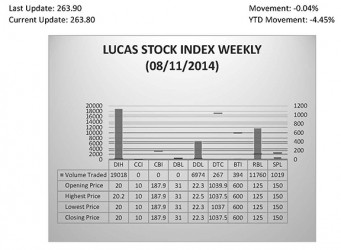Revolting news
In its mid-year report, the government disclosed that the Guyana economy grew by 3.2 per cent. Almost all the sectors made highly favourable contributions to the economic situation. Only the high-profile gold industry did not contribute as much as it did in previous periods. That outcome was because production was down 17 per cent and export earnings from the precious metal had taken an even bigger hit of 25 per cent. Overall, the economy is expected to grow by 4.5 per cent by year’s end, thus maintaining an unbroken streak of upward movement in the production and earnings of the country. Undoubtedly, the news on the economy was intended to make Guyanese households and investors alike feel good about themselves knowing that their consumption and investment spending was helping the economy to expand. But the anticipated feeling of jubilation was blunted by the flurry of revealing news and pictures linked to the forestry sector that kept appearing on a daily basis in one of the major newspapers during the course of the last week. The stories and pictures were about Bai Shan Lin, a foreign investor from China, which appears to be mercilessly exploiting the forest resources of Region 10. At least more Guyanese might now get a better understanding of what some of the economic complaints of Region 10 have been all about.
Forestry
 One of the sectors that contributed positively to the good mid-year performance of the economy was that of forestry. According to news reports, the output of the forestry sector grew by more than 38 per cent during the first half of the year. As could be expected, the export revenues of this sector also grew, expanding by more than 31 per cent. These are favourable developments for the forestry sector since it has been in a production slump for a while as could be seen from the table below. Even without the stories about Bai Shan Lin, the sudden uptick in the forestry sector would have attracted the curiosity of the more attentive Guyanese, whether looking for a job, investment opportunities or some other favourable situation.
One of the sectors that contributed positively to the good mid-year performance of the economy was that of forestry. According to news reports, the output of the forestry sector grew by more than 38 per cent during the first half of the year. As could be expected, the export revenues of this sector also grew, expanding by more than 31 per cent. These are favourable developments for the forestry sector since it has been in a production slump for a while as could be seen from the table below. Even without the stories about Bai Shan Lin, the sudden uptick in the forestry sector would have attracted the curiosity of the more attentive Guyanese, whether looking for a job, investment opportunities or some other favourable situation.
Any discussion of the forestry sector must look at the trend in that area and the national development interests and potential to which it is linked. That discussion cannot be divorced from the management and leadership of the natural resources sector since in most, if not all instances, forestry could be involved. Where forests exist, one has to remove the forest cover before any agricultural, mining or industrial activity could take place. Under those circumstances, economic development is explicitly a function of forest removal, whether for its own economic benefit or to facilitate the activities of other sectors. On the other hand, for sustainable development to be assured, forest protection must become a function of economic development. Policies and technologies developed and used in the economy must favour and enable forest protection.
Proxy for economic development
To the extent that gross domestic product (GDP) is a proxy for economic development, the 2014 half-year economic report of the government reveals information that follows the logic of economic development being an explicit function of forest removal. Part of the reason that the economy expanded was because forest production (removal) expanded. Reporting on the sector in this manner does not bring out any information about environmental sustainable gains. The table below reveals that all three types of forestry products were in crisis before this year leading to the conclusion that forest removal had slowed. In one instance, the Bank of Guyana reported that the adoption of strict monitoring and implementation of sustainable forestry practices was responsible for the slowing of forest removal.
Lagging production
The year 2006 represents the point against which the production of subsequent periods is compared. The output of greenheart and other logs were lagging in production since 2007 and up to last year were producing about 23 per cent less logs than in the base year of 2006. The plywood product was in even worse shape. Since 2007, production of plywood was in freefall until last year when it suddenly reversed its fortunes. Even the sawn-wood product which has been the most favourable performer hit a snag during a part of the period in review. While production was higher than the base year 2006 throughout the period of review, the rate of output was declining every year since 2010. In effect, the output of sawnwood was in a sustained decline over the last four years.
Turnaround
The turnaround of the sector in 2014 is a welcome development and is being attributed by the government to the availability of new incentives to harvesters. This posture implies that there are no sustainability risks from the forest removal and this article does not discuss that issue. No information on the destination of the forestry exports has been provided, but one suspects that the market is China. Indeed, it would be difficult to remove the heavy demand in China for logs, lumber and wood products from the set of likely reasons for the sudden expansion of Guyana’s forest exports. Persons with better knowledge of the global market for timber products know that China has no forest industry to speak about. During the early days of Communist Party domination, the forests of China were improperly managed leading to forest depletion and destruction. A series of severe and catastrophic floods led China to implement a National Forest Protection Plan in an effort to restore its forest and regain some environmental protection from natural disasters that forests can provide. China also imposed a ban on logging in 1998. Ever since then, China has been increasing its import of forest products.
From 1990 to 2009, China’s share of global timber imports climbed from 10 to 30 per cent. This share was likely to increase further with the inadequate domestic supply and the insatiable demand for timber. The reason behind China’s demand for timber imports is the need for it to build 350 million houses in a 20-year span or the equivalent of 17.5 million houses per year as a result of internal migration. For Guyanese who still dream of becoming one million, the thought of building more than 17 million houses per year is mind-boggling. The seemingly insatiable Chinese demand for timber that comes with a booming construction industry creates irresistible opportunities to make money.
A 2012 report by the Commissioner of Public Lands of the Department of Natural Resources of the State of Washington in the United States of America observed that no one country was dominating or supplying the total timber product needs of China. Part of the reason stemmed from the imposition of a 25 per cent tariff by Russia, China’s one-time premier supplier, which made wood imports into China mighty expensive. In addition to traditional suppliers like Russia, Canada, the USA and New Zealand, China now buys wood and logs from an array of other countries. Key trading partners for this product include Cambodia, Indonesia, Malaysia, Thailand, and Vietnam in South East Asia, and Brazil and Chile in South America. Together these suppliers exported 7 million tons of hardwood chips to China in 2011, and are now collectively the leading suppliers of logs and wood to that country.
China is sourcing wood from countries in Africa and other countries in South America as well. In a case study done on China’s trade and investment in Mozambique’s timber industry, it was revealed that Mozambique was one of the top five African countries that exported timber to China, others being Cameroon, Congo and Gabon. The case study also revealed that more than 80 per cent of the timber exports of Mozambique went to China and that the latter was willing to pay premium prices for logs. In other reports, China’s forest activities in Africa have led to poor labour conditions, undermined forest governance and encouraged illegal timber trading and corruption.
Good management
When one thinks of what has happened in Africa, it is not the mere destruction of the forest in Region 10 that is alarming and of concern. Other economic activities including gold and agricultural production would require the removal of forest cover for those activities to take place. As in the story between the chicken and the pig about having ham and eggs for breakfast, like the pig, the forest is involved. Development cannot take place without some destruction of the forest. Cutting and selling timber is therefore nothing unusual and alarming. What matters is how the natural resources are managed for sustainable development in the face of extraction. Good management would ensure that there was a balance between the economic value from timber production and the environmental risks linked to that activity. In other words, it would demonstrate proper use and supervision of the low-carbon development strategy as it relates to the extraction and export of forestry resources.
The conflicting responses from the government over the scope of activities that Bai Shan Lin should be undertaking at this stage demonstrate that management is not taking place. Each government entity – the Environmental Protection Agency and the Guyana Forestry Commission – seems to think that it could act at cross purposes and still be consistent with the agreement reached with the investor and the laws of Guyana. Such confusion creates room for cheating and gives credence to the fears that illegal trading in Wamara, and other corrupt practices, might be occurring. One must therefore ask, where is the Ministry of Natural Resources and the Environment in all of this confusion? Good management also means that Bai Shan Lin should not be allowed to exploit the resources of Region 10 while showing marginal interest in developing and maintaining the already limited infrastructure of the Region that supports its activities.
Prejudicial
The aggressive and blind pursuit of the forest resources of Region 10 has left Bai Shan Lin looking like an irresponsible corporate citizen. Bai Shan Lin’s unchecked abuse of Guyanese living in Region 10 also makes the government look prejudicial in dealing with the social, economic and environmental concerns of this nation. But what else could one expect from a government that regards every Guyanese who does not think and act like it does as unpatriotic? It is a welcome relief to hear that some committees of the legislature are interested in knowing more about Guyana’s management of its forest resources and Bai Shan Lin’s role in that process.
LUCAS STOCK INDEX
The Lucas Stock Index (LSI) fell 0.04 per cent in relatively light trading in the second period of August 2014. The stocks of six companies were traded with 39,432 shares changing hands. There were no Climbers but one Tumbler. The value of the stocks of Demerara Tobacco Company (DTC) declined 0.23 per cent on the sale of 267 shares. In the meanwhile, the value of the stocks of Banks DIH (DIH), Demerara Distillers Limited (DDL), Guyana Bank for Trade and Industry (BTI), Republic Bank Limited (RBL) and Sterling Products Limited (SPL) remained unchanged on the sale of 19,018; 6,974; 394; 11,760 and 1,019 shares respectively.









